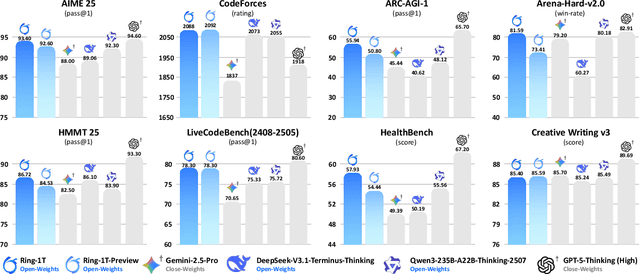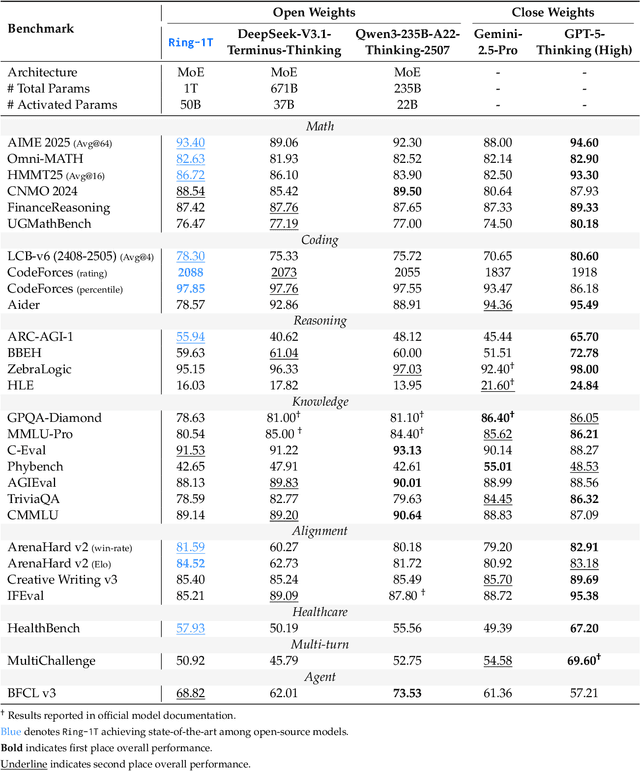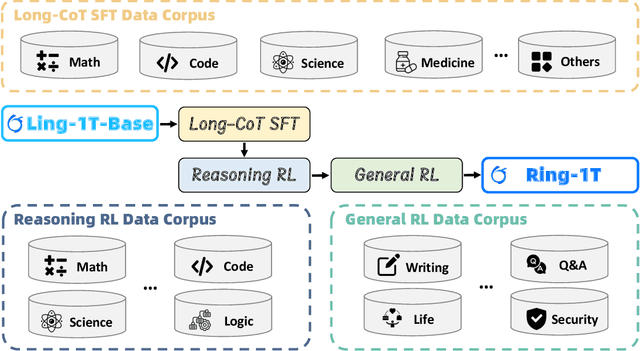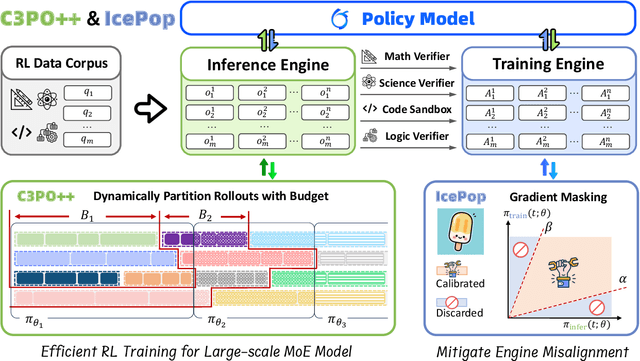Haonan Zheng
Every Step Evolves: Scaling Reinforcement Learning for Trillion-Scale Thinking Model
Oct 21, 2025



Abstract:We present Ring-1T, the first open-source, state-of-the-art thinking model with a trillion-scale parameter. It features 1 trillion total parameters and activates approximately 50 billion per token. Training such models at a trillion-parameter scale introduces unprecedented challenges, including train-inference misalignment, inefficiencies in rollout processing, and bottlenecks in the RL system. To address these, we pioneer three interconnected innovations: (1) IcePop stabilizes RL training via token-level discrepancy masking and clipping, resolving instability from training-inference mismatches; (2) C3PO++ improves resource utilization for long rollouts under a token budget by dynamically partitioning them, thereby obtaining high time efficiency; and (3) ASystem, a high-performance RL framework designed to overcome the systemic bottlenecks that impede trillion-parameter model training. Ring-1T delivers breakthrough results across critical benchmarks: 93.4 on AIME-2025, 86.72 on HMMT-2025, 2088 on CodeForces, and 55.94 on ARC-AGI-v1. Notably, it attains a silver medal-level result on the IMO-2025, underscoring its exceptional reasoning capabilities. By releasing the complete 1T parameter MoE model to the community, we provide the research community with direct access to cutting-edge reasoning capabilities. This contribution marks a significant milestone in democratizing large-scale reasoning intelligence and establishes a new baseline for open-source model performance.
Sample-agnostic Adversarial Perturbation for Vision-Language Pre-training Models
Aug 06, 2024



Abstract:Recent studies on AI security have highlighted the vulnerability of Vision-Language Pre-training (VLP) models to subtle yet intentionally designed perturbations in images and texts. Investigating multimodal systems' robustness via adversarial attacks is crucial in this field. Most multimodal attacks are sample-specific, generating a unique perturbation for each sample to construct adversarial samples. To the best of our knowledge, it is the first work through multimodal decision boundaries to explore the creation of a universal, sample-agnostic perturbation that applies to any image. Initially, we explore strategies to move sample points beyond the decision boundaries of linear classifiers, refining the algorithm to ensure successful attacks under the top $k$ accuracy metric. Based on this foundation, in visual-language tasks, we treat visual and textual modalities as reciprocal sample points and decision hyperplanes, guiding image embeddings to traverse text-constructed decision boundaries, and vice versa. This iterative process consistently refines a universal perturbation, ultimately identifying a singular direction within the input space which is exploitable to impair the retrieval performance of VLP models. The proposed algorithms support the creation of global perturbations or adversarial patches. Comprehensive experiments validate the effectiveness of our method, showcasing its data, task, and model transferability across various VLP models and datasets. Code: https://github.com/LibertazZ/MUAP
A Unified Understanding of Adversarial Vulnerability Regarding Unimodal Models and Vision-Language Pre-training Models
Jul 25, 2024



Abstract:With Vision-Language Pre-training (VLP) models demonstrating powerful multimodal interaction capabilities, the application scenarios of neural networks are no longer confined to unimodal domains but have expanded to more complex multimodal V+L downstream tasks. The security vulnerabilities of unimodal models have been extensively examined, whereas those of VLP models remain challenging. We note that in CV models, the understanding of images comes from annotated information, while VLP models are designed to learn image representations directly from raw text. Motivated by this discrepancy, we developed the Feature Guidance Attack (FGA), a novel method that uses text representations to direct the perturbation of clean images, resulting in the generation of adversarial images. FGA is orthogonal to many advanced attack strategies in the unimodal domain, facilitating the direct application of rich research findings from the unimodal to the multimodal scenario. By appropriately introducing text attack into FGA, we construct Feature Guidance with Text Attack (FGA-T). Through the interaction of attacking two modalities, FGA-T achieves superior attack effects against VLP models. Moreover, incorporating data augmentation and momentum mechanisms significantly improves the black-box transferability of FGA-T. Our method demonstrates stable and effective attack capabilities across various datasets, downstream tasks, and both black-box and white-box settings, offering a unified baseline for exploring the robustness of VLP models.
 Add to Chrome
Add to Chrome Add to Firefox
Add to Firefox Add to Edge
Add to Edge